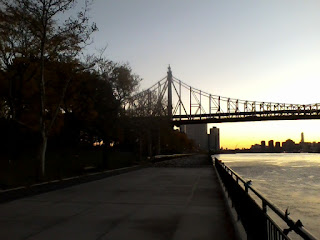Tomorrow the New York City Marathon will wind its way through the Big Apple's five boroughs. Knowing that, the pub crawls that will snake their way through various Gotham neighborhoods--as well as cities all over North America--today seem oddly appropriate.
Hmm...I wonder how many people will make the rounds of bars today and round the turns of tomorrow's run.
The first time I heard about Halloween pub crawls, it occured to me that it's what people do when they don't want to grow up but are too old for "Trick or Treat."
Most of those becostumed kids who knock on doors are in cities or relatively compact suburbs or towns. And, of course, all of those pub crawls are in urban enclaves of young professionals.
So what does one do when separated from his or her nearest neighbors by miles of prairie or mountains or soybean fields or whatever? Do kids in such places go Trick or Treating? (I'm guessing there aren't many young professionals in such places,and whatever twenty- and thirty-somethings are living in them have other things to do!) If so, how?
Well...I have a hard time imagining their parents driving them from one potential shakedown site to the next. Could it be that they're riding from house to house on bicycles?
Why not? I've seen racer-wannabes in team kit who looked more ridiculous than anything I've shown in this post.
Happy Halloween.
Hmm...I wonder how many people will make the rounds of bars today and round the turns of tomorrow's run.
The first time I heard about Halloween pub crawls, it occured to me that it's what people do when they don't want to grow up but are too old for "Trick or Treat."
Most of those becostumed kids who knock on doors are in cities or relatively compact suburbs or towns. And, of course, all of those pub crawls are in urban enclaves of young professionals.
So what does one do when separated from his or her nearest neighbors by miles of prairie or mountains or soybean fields or whatever? Do kids in such places go Trick or Treating? (I'm guessing there aren't many young professionals in such places,and whatever twenty- and thirty-somethings are living in them have other things to do!) If so, how?
Well...I have a hard time imagining their parents driving them from one potential shakedown site to the next. Could it be that they're riding from house to house on bicycles?
Why not? I've seen racer-wannabes in team kit who looked more ridiculous than anything I've shown in this post.
Happy Halloween.





















